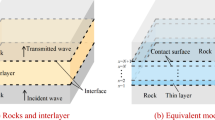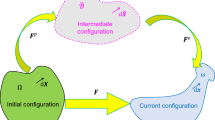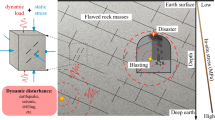Abstract
In the process of 2-D compressional wave propagation in a rock mass with multiple parallel joints along the radian direction normal to the joints, the maximum possible wave amplitude corresponding to the points between the two adjacent joints in the joint set is controlled by superposition of the multiple transmitted and the reflected waves, measured by the maximum rebound ratio. Parametric studies on the maximum rebound ratio along the radian direction normal to the joints were performed in universal distinct element code. The results show that the maximum rebound ratio is influenced by three factors, i.e., the normalized normal stiffness of joints, the ratio of joint spacing to wavelength and the joint from which the wave rebounds. The relationship between the maximum rebound ratio and the influence factors is generalized into five charts. Those charts can be used as the prediction model for estimating the maximum rebound ratio.
Similar content being viewed by others
References
Bedford A, Drumheller D S. Introduction to elastic wave propagation [M]. 1st ed. Chichester: John Wiley and Sons, 1994.
Schoenberg M. Elastic wave behavior across linear slip interfaces[J]. Journal of Acoustics Society of America, 1980, 68(5): 1516–1521.
Pyrak-Nolte L J. The seismic visibility of fractures[D]. California: University of California Berkeley, 1988.
Pyrak-Nolte L J, Myer L R, Cook N G W. Anisotropy in seismic velocities and amplitudes from multiple parallel fractures[J]. Journal of Geophysical Research, 1990, 95(B7): 11345–11358.
Cai J G, Zhao J. Effects of multiple parallel fractures on apparent wave attenuation in rock masses[J]. International Journal of Rock Mechanics and Mining Sciences, 2000, 37(4): 661–682.
Zhao J, Cai J G. Transmission of elastic P-waves across single fractures with a nonlinear normal deformational behavior[J]. Rock Mechanics and Rock Engineering, 2001, 34(1): 3–22.
Lei W D. Numerical studies on 2-D compressional wave propagation in jointed rock masses due to impact load in tunnels and boreholes[D]. Singapore: Nanyang Technological University, 2005.
Lei W D, Teng J, Hefny M A, et al. Transmission ratio (T n) in the radian direction normal to joints in 2-D compressional wave propagation in rock masses[J]. Journal of University of Science and Technology Beijing, 2006, 13(3):199–206.
Lei W D, Hefny M A, Teng J, et al. Verification of numerical modeling in 2-D wave propagation in rock[J]. Journal of China University of Mining and Technology: English Edition, 2005, 15(4): 309–313.
Lei W D, Hefny M A, Zhao J. Pilot studies on two dimensional wave propagation in rock masses[J]. Transactions of. Nonferrous Metals Society of China, 2005, 15(4): 949–955.
Chen S G, Cai J G, Zhao J, et al. Discrete element modeling of an underground explosion in jointed rock mass[J]. Geotechnical and Geological Engineering, 2000, 18(2): 59–78.
Chen S G, Zhao J. A study of UDEC modeling for blast wave propagation in jointed rock masses[J]. International Journal of Rock Mechanics and Mining Sciences, 1998, 35(1): 93–99.
Lee C B. Fracturing characteristics of Bukit Timah granite[D]. Singapore: Nanyang Technological University, 2002.
Itasca Consulting Group Inc. UDEC manual[K]. Minneapolis, 1996
Author information
Authors and Affiliations
Corresponding author
Additional information
Foundation item: Projects(50278057) supported by the National Natural Science Foundation of China; project(2002CB412703) supported by Major State Basic Research Development Program of China
Rights and permissions
About this article
Cite this article
Lei, Wd., Teng, J., Hefny, A. et al. Numerical study on maximum rebound ratio in blasting wave propagation along radian direction normal to joints. J Cent. South Univ. Technol. 13, 743–748 (2006). https://doi.org/10.1007/s11771-006-0025-5
Received:
Accepted:
Published:
Issue Date:
DOI: https://doi.org/10.1007/s11771-006-0025-5




